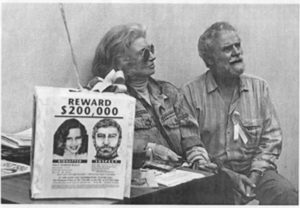The call came in exactly 20-hours after Polly was kidnapped from a slumber party in her home. Violet and I had left our home in Sausalito that morning, but a trusted relative was housesitting for us just in case she did call. The sun had gone down, dusk was settling over the valley and I was beginning to freak out when we were informed about the phone call. The situation, which was becoming darker by the minute, suddenly looked like it might turn into a weekend adventure after all. We exhaled a sigh of relief and waited for law enforcement to wrap up the case.
Somebody has been masquerading as Sierra LaMar in various social network communities. This activity began not long after she was reported missing. On April 18, it was through her twitter account. Initially, Sierra’s sister Danielle thought that the post might be from her sister, but she quickly realized that if Sierra wanted to communicate to her family, she would call and not post online. The most recent postings occurred on June 18: first an Instagram message, and then a Facebook posting. Danielle considers these most recent hoaxes as nothing more than a mean spirited sideshow.
The minutes dragged into the deep night and then the early morning hours and we still hadn’t heard back from the authorities. It had all seemed so simple. The message was brief and unambiguous, “It’s me, Polly! I’m at the Day’s Inn in Daly City. Hurry, he’s coming back,” and then the line went dead. So, what was taking so long, and why hadn’t they rescued her yet?
Hoaxes are never funny or clever. They are nothing more than lies disguised as truth, designed to misdirect and obscure, oftentimes with devastating results. Unless it is April Fool’s Day, and they are executed in the spirit of fun, hoaxes have no redeeming qualities whatsoever. When you are dealing with life or death situations, such as a missing child event, hoaxes are a cruel display of ignorance and a lack of empathy for people in dire straits.
By 3:00 a.m. I was staring at the ceiling of a motel room in Petaluma. There were others in the room and the regulated breathing indicated that they were asleep. I got up, put on my shoes and shirt and quietly left the room. There was a slight chill in the air and the full moon lighted the sky. I crossed the street. All was quiet as I walked to the middle of the empty supermarket parking lot. I fell to my knees and unloaded a banshee scream that could be heard in the heavens because I needed the attention of the God who had forsaken my child.
It’s bad enough that false hope is raised for a short period of time only to be replaced by cold, hard reality. Other dynamics are at work as well. As much as we search for Sierra, opine about Sierra and pray for her safe return, the ultimate resolution of this case is in the hands of the authorities. They need to maintain their focus and pursue solid evidence and leads. The Sierra LaMar Taskforce has to redirect its investigation to deal with false leads, hard rumors, and lies. This costs time, drains resources and may cost the victim dearly. It affects morale and delays justice.
After some period of time had passed I felt a hand upon my shoulder. I turned and looked up into Violet’s eyes, illuminated in the moonlight. I knew that she shared my agony, and wordlessly we returned to the motel, entering quietly so as not to wake up the rest of my family. At 8:00 a.m., approximately 12-hours after my brother-in-law received the call from the little girl, the FBI told me that there was no Days Inn in Daly City. They had searched every motel in Daly City as well as every Day’s Inn from San Francisco to San Jose only to realize that the phone call was nothing more than a hoax.
These Internet hoaxes are the product of a malicious, weak mind. They bring a degree of shame on a community that has otherwise responded magnificently to the plight of a child who found comfort and delight in the very social media communities that now seem to conspire against her.
By the time the next call came a week later the FBI had put a trap on our phone. My sister-in-law answered and kept the girl on line long enough to trace the source. She also asked her to describe the poster above her bed, which she couldn’t do. She was 13-years-old and was just pulling a prank: a mean spirited stunt that had no purpose other than piling on the agony and offering a moment of false hope.








